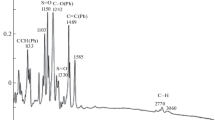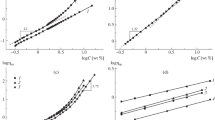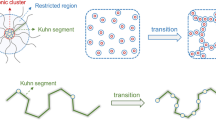Abstract
Polymer chains consisting of water-soluble polysulfones with various amounts of ionic chlorine have been prepared via the quaternization reaction of chloromethylated polysulfones with N,N-dimethylethanolamine. Rheological investigations have reflected the importance of electrostatic interactions, hydrogen bonding, and association phenomena from the ternary systems consisting of a proton-acceptor polymer (polysulfones with different ionic chlorine content), a proton-donor solvent (N,N-dimethylformamide), and a proton-donor solvent (methanol). The specific interactions, the polyelectrolyte effect induced by enhanced dissociation of the ionizable groups and mixed solvents’ quality modify the rheological functions, i.e., dynamic viscosity, elastic shear modulus and viscous shear modulus, as well as the thermodynamic parameters obtained from the rheological properties, such as apparent energy of activation and flow activation entropy. These results were correlated with the surface properties of the polysulfonic films formed from solutions in solvent/nonsolvent mixtures.














Similar content being viewed by others
References
Barikani M, Mehdipour-Ataei S (2000) Synthesis, characterization and thermal properties of novel arylene sulfone ether polyimides and polyamides. J Polym Sci A 38:1487–1492. doi:10.1002/(SICI)1099-0518(20000501
Barzin J, Feng C, Khulbe KC, Matsuura T, Madaeni SS, Mirzadeh H (2004) Characterization of polyethersulfone hemodialysis membrane by ultrafiltration and atomic force microscopy. J Membr Sci 237:77–85. doi:10.1016/j.memsci.2004.02.029
Higuchi A, Iwata N, Tsubaki M, Nakagawa T (1988) Surface-modified polysulfone hollow fibers. J Appl Polym Sci 36:1753–1767. doi:10.1002/app.1988.070360804
Higuchi A, Shirano K, Harashima M, Yoon BO, Hara M, Hattori M, Imamura K (2002) Chemically modified polysulfone hollow fibers with vinylpyrrolidone having improved blood compatibility. Biomaterials 23:2659–2666. doi:10.1016/S0142-9612(01)00406-9
Tomaszewska M, Jarosiewicz A, Karakulski K (2002) Physical and chemical characteristics of polymer coatings in CRF formulation. Desalination 146:319–323. doi:10.1016/S0011-9164(02)00501-5
Savariar S, Underwood GS, Dickinson EM, Schielke PJ, Hay AS (2002) Polysulfone with lower levels of cyclic dimmer: use of MALDI-TOF in the study of cyclic oligomers. Desalination 144:15–20. doi:10.1016/S0011-9164(02)00282-5
Sotiroiu K, Pispas S, Hadjichristidis N (2004) Effect of the end-positioning of a lithium sulfonate group on the aggregation and micellization behavior of ω-lithium sulfonate polystyrene-block-polyisoprenes. Macromol Chem Phys 205:55–62. doi:10.1002/macp.200300049
Ismail AF, Hafiz WA (2002) Effect of polysulfone concentration on the performance of membrane-assisted lead acid battery. J Sci Technol 24:815–821 ISSN 0125-3395
Ydens I, Moins S, Degée P, Dubois P (2005) Solution properties of well-defined 2-(dimethylamino) ethyl methacrylate-based (co)polymers: a viscometric approach. Eur Polym J 41:1502–1509. doi:10.1016/j.eurpolymj.2005.02.002
Ghimici L, Avram E (2003) Viscometric behavior of quaternized polysulfones. J Appl Polym Sci 90:465–469. doi:10.1002/app.12677
Ioan S, Filimon A, Avram E (2006) Influence of the degree of substitution on the solution properties of chloromethylated polysulfone. J Appl Polym Sci 101:524–531. doi:10.1002/app.23340
Ioan S, Filimon A, Avram E (2006) Conformational and viscometric behavior of quaternized polysulfone in dilute solution. Polym Eng Sci 46:827–836. doi:10.1002/pen.20526
Filimon A, Avram E, Ioan S (2007) Influence of mixed solvents and of temperature on the solution properties of quaternized polysulfones. J Macromol Sci B 46:503–520. doi:10.1080/00222340701257752
Filimon A, Albu RM, Avram E, Ioan S (2010) Effect of alkyl side chain on the conformational properties of polysulfones with quaternary groups. J Macromol Sci B 49:207–217. doi:10.1080/00222340903346494
Guan R, Zou H, Lu D, Gong C, Liu Y (2005) Polyetheresulfone sulfonated by chlorosulfonic acid and its membrane characteristics. Eur Polym J 41:1554–1560. doi:10.1016/j.eurpolymj.2005.01.018
Saha N, Saarai A, Roy N, Kitano T, Saha P (2011) Polymeric biomaterial based hydrogels for biomedical applications. J Biomater Nanobiotechnol 2:85–90. doi:10.4236/jbnb.2011.21011
Yu H, Huang Y, Ying H, Xiao C (2007) Preparation and characterization of a quaternary ammonium derivative of konjac glucomannan. Carbohydr Polym 69:29–40. doi:10.1016/j.carbpol.2006.08.024
Filimon A, Avram E, Dunca S, Stoica I, Ioan S (2009) Surface properties and antibacterial activity of quaternized polysulfones. J Appl Polym Sci 112:1808–1816. doi:10.1002/app.29591
Idris A, Zain NM (2007) Synthesis, characterization and performance of asymmetric polyethersulfone (PES) ultrafiltration membranes with polyethylene glycol of different molecular weights as additives. Desalination 207:324–339. doi:10.1016/j.desal.2006.08.008
Kochkodan V, Tsarenko S, Potapchenko N, Kosinova V, Goncharuk V (2008) Adhesion of microorganisms to polymer membranes: a photobactericidal effect of surface treatment with TiO2. Desalination 220:380–385. doi:10.1016/j.desal.2007.01.042
Guiver MD, Black P, Tam CM, Deslandes Y (1993) Functionalized polysulfone membranes by heterogeneous lithiation. J Appl Polym Sci 48:1597–1606. doi:10.1002/app.1993.070480912
Huang Y, Xiao C (2007) Miscibility and mechanical properties of quaternized polysulfone/benzoyl guar gum blends. Polymer 48:371–381. doi:10.1016/j.polymer.2006.10.041
Avram E, Butuc E, Luca C (1997) Polymers with pendent functional groups. III. Polysulfone containing viologen group. J Macromol Sci A 34:1701–1714. doi:10.1080/10601329708010036
Avram E (2001) Polymers with pendent functional groups. VI. A comparative study on the chloromethylation of linear polystyrene and polysulfone with paraformaldehyde/Me3SiCl. Polym Plast Technol Eng 40:275–281. doi:10.1081/PPT-100000248
Luca C, Avram E, Petrariu I (1988) Quaternary ammonium polyelectrolytes. V. Amination studies of chloromethylated polystyrene with N,N-dimethylalkylamines. J Macromol Sci A 25:345–361. doi:10.1080/00222338808053373
Ioan S, Filimon A, Avram E (2005) Influence of substitution degree to the optical properties of chloromethylated polysulfone. J Macromol Sci B 44:129–135. doi:10.1081/MB-200044623
Filimon A, Avram E, Ioan S (2009) Specific interactions in ternary system quaternized polysulfone/mixed solvent. Polym Eng Sci 49:17–25. doi:10.1002/pen.21209
Ioan S, Filimon A, Avram E, Ioanid G (2007) Effects of chemical structure and of the plasma treatment on the surface properties of polysulfones. e-Polymers 031:1–13 ISSN: 1618-7229
Ioan S, Filimon A (2011) Biocompatibility and antimicrobial activity of some quaternized polysulfones. In: Varaprasad B (ed) Antibacterial agents/book 2. InTech Publisher, Rijeka ISBN: 979-953-307-747-4
HyperChem™ (2001) HyperChem professional program. Hypercube, Inc., Gainesville, FL
Kotlyarevskaya OO, Navrotskii VA, Orlyanskii MV, Navrotskii AV, Novakov IA (2005) Hydrodynamic behavior of N, N-dimethylaminoethyl methacrylate polylectrolytes in mixed solvents. Polym Sci Ser A 47:313–318 ISSN: 1023-3091
McKee MG, Hunley MT, Layman JM, Long TE (2006) Solution rheological behavior and electrospinning of cationic polyelectrolytes. Macromolecules 39:575–583. doi:10.1021/ma051786u
McKee MG, Elkins CL, Long TE (2004) Influence of self-complementary hydrogen bonding on solution rheology/electrospinning relationships. Polymer 45:8705–8715. doi:10.1016/j.polymer.2004.10.049
de Vasconcelos CL, Martins RR, Ferreira MO, Pereira MR, Fonseca JLC (2002) Rheology of polyurethane solutions with different solvents. Polym Int 51:69–74. doi:10.1002/pi.800
Gupta K, Yaseen M (1997) Viscosity-temperature relationship of dilute solution of poly(vinyl chloride) in cyclohexanone and in its blends with xylene. J Appl Polym Sci 65:2749–2760. doi:10.1002/(SICI)1097-4628(19970926)65:13<2749:AID-APP18>3.0.CO;2-S
Hirai N, Eyring H (1958) Bulk viscosity of liquids. J Appl Phys 29:810–817. doi:10.1063/1.1723290
Ferry JD (1980) Viscoelasticity properties of polymer. Wiley, New York
Qian JW, An QF, Wang LN, Zhang L, Shen L (2005) Influence of the dilute-solution properties of cellulose acetate in solvent mixtures on the morphology and pervaporation performance of their membranes. J Appl Polym Sci 97:1891–1898. doi:10.1002/app.21923
Huang DH, Ying YM, Zhuang GQ (2000) Influence of intermolecular entanglements on the glass transition and structural relaxation behaviors of macromolecules. 2. Polystyrene and phenolphthalein poly(ether sulfone). Macromolecules 33:461–464. doi:10.1021/ma990786p
Kesting RE (1990) The four tiers of structure in integrally skinned phase inversion membranes and their relevance to the various separation regimes. J Appl Polym Sci 41:2739–2752. doi:10.1002/app.1990.070411120
Bhuiyan MMH, Uddin MH (2008) Excess molar volumes and excess viscosities for mixtures of N,N-dimethylformamide with methanol, ethanol and 2-propanol at different temperatures. J Mol Liquids 138:139–146. doi:10.1016/j.molliq.2007.07.006
Author information
Authors and Affiliations
Corresponding author
Rights and permissions
About this article
Cite this article
Filimon, A., Avram, E. & Ioan, S. Structure–rheology relationship in complex quaternized polysulfones/solvent/nonsolvent systems. Polym. Bull. 70, 1835–1851 (2013). https://doi.org/10.1007/s00289-012-0874-z
Received:
Revised:
Accepted:
Published:
Issue Date:
DOI: https://doi.org/10.1007/s00289-012-0874-z




